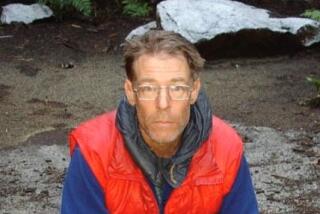Book Review : A Scientist Drawn to the Big Questions
- Share via
The River That Flows Uphill: A Journey From the Big Bang to the Big Brain by William H. Calvin (Macmillan: $25)
Scientists, William H. Calvin tells us a little way into this book, come in two varieties: splitters and lumpers.
Splitters make distinctions. They give a different name to every variation and subdivision they see. Lumpers, on the other hand, emphasize similarities. They lump related things into one category with one name.
It is usually wise to shift back and forth between these approaches. Many similarities are important, and so are many differences. The trick is to know which is which and to be ready to revise one’s judgment.
Calvin, a neurobiologist at the University of Washington, is an author who does indeed shift back and forth, now splitting, now lumping, as data, context and temperament suggest. And he puts this considerable skill to good use in “The River That Flows Uphill,” a thick book (500 pages) that seeks to encompass everything that is known--and almost makes it.
When I say everything that is known, I mean everything that is known. No kidding. In this thoughtful and thought-provoking book, which uses a two-week raft trip in the Grand Canyon as a metaphor for evolution and all of life, Calvin discourses on many, many topics, including:
A Quirky List
How the brain works; how the genetic code works; zero-population growth; the neurobiology of learning; and how empty-channel snow on your TV set gives evidence of the Big Bang that created the universe.
The book is packed with informed speculation about many big questions: evolution, life, personality, thought, consciousness. In short, the works. Calvin retains a child’s wonder at the world. He writes of scientific puzzles and human puzzles, and his most frequent thought is Why?
At one point, Calvin outlines the kinds of questions that drew him and his colleagues into neurobiology in the first place:
“What is Consciousness? Is there a Higher Consciousness? What is Meaning? What does it mean to Think? How do I form Beliefs, a Will to do something? Is there a Soul? Is there anything more to it than Materialism? How do I really Know something? What about Intent and Motive, the Self, the Ego? Is there room for Dualism?”
(The capitalization is Calvin’s. A brass thingamajig with oak-leaf cluster will be awarded to anyone who can explain Calvin’s capitalization rule.) Of course, Calvin’s questions and others like them are unassailable at the present state of knowledge, at least. For all we know, they may be forever unanswerable.
Large questions have drawn many scientists to the lab bench. Many of them--too many, perhaps--eventually stop thinking about these sorts of things and concentrate on what little can be known.
Not Calvin. The big questions (Big Questions?) are still with him, and he chews them over in this book.
With this big buildup, you’d think Calvin had written a crackerjack book. He almost has.
Extended Travel Article
For one thing, there is the structure. On one level, this book is an extended travel article in which we spend two weeks rafting down the Colorado River, running rapids, hiking, camping, learning geology and astronomy and a host of other things and musing on this and that.
The musing leads to essays on Calvin’s other topics, frequently without so much as a transition. Then we find out in a postscript that the river trip depicted in this book did not actually all take place as written. It’s a composite of several Colorado River trips that Calvin made, and he has taken some liberties with characters as well. Since the structure seems forced anyway, why bother?
What’s more, while Calvin is a very good explainer, his descriptive writing is not as good. He runs out of adjectives for describing the Grand Canyon, more than once resorting to “spectacular.”
Calvin is a very smart guy and a fine synthesizer. He knows a lot, and his book is interesting and idiosyncratic. All to the good. Undoubtedly many readers will enjoy this book, and every reader will certainly learn a great deal.
But why do the folks at Macmillan put a question mark after a statement? “I wonder where they’re going?” the author writes. All the wonder is contained in the word wonder . No question mark necessary.
More to Read
Sign up for our Book Club newsletter
Get the latest news, events and more from the Los Angeles Times Book Club, and help us get L.A. reading and talking.
You may occasionally receive promotional content from the Los Angeles Times.






